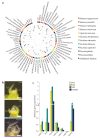TM3 and STM3 Promote Flowering Together with FUL2 and MBP20, but Act Antagonistically in Inflorescence Branching in Tomato
- PMID: 37570908
- PMCID: PMC10420972
- DOI: 10.3390/plants12152754
TM3 and STM3 Promote Flowering Together with FUL2 and MBP20, but Act Antagonistically in Inflorescence Branching in Tomato
Abstract
The moment at which a plant transitions to reproductive development is paramount to its life cycle and is strictly controlled by many genes. The transcription factor SUPPRESSOR OF OVEREXPRESSION OF CONSTANS 1 (SOC1) plays a central role in this process in Arabidopsis. However, the role of SOC1 in tomato (Solanum lycopersicum) has been sparsely studied. Here, we investigated the function of four tomato SOC1 homologs in the floral transition and inflorescence development. We thoroughly characterized the SOC1-like clade throughout the Solanaceae and selected four tomato homologs that are dynamically expressed upon the floral transition. We show that of these homologs, TOMATO MADS 3 (TM3) and SISTER OF TM3 (STM3) promote the primary and sympodial transition to flowering, while MADS-BOX PROTEIN 23 (MBP23) and MBP18 hardly contribute to flowering initiation in the indeterminate cultivar Moneyberg. Protein-protein interaction assays and whole-transcriptome analysis during reproductive meristem development revealed that TM3 and STM3 interact and share many targets with FRUITFULL (FUL) homologs, including cytokinin regulators. Furthermore, we observed that mutating TM3/STM3 affects inflorescence development, but counteracts the inflorescence-branching phenotype of ful2 mbp20. Collectively, this indicates that TM3/STM3 promote the floral transition together with FUL2/MBP20, while these transcription factors have opposite functions in inflorescence development.
Keywords: FRUITFULL; MADS-box transcription factor; SUPPRESSOR OF OVEREXPRESSION OF CONSTANS 1; Solanum lycopersicum; floral transition; inflorescence architecture; reproductive meristems.
Conflict of interest statement
The authors declare no conflict of interest. The funders had no role in the design of the study; in the collection, analyses, or interpretation of data; in the writing of the manuscript; or in the decision to publish the results.
Figures





Similar articles
-
FRUITFULL-like genes regulate flowering time and inflorescence architecture in tomato.Plant Cell. 2022 Mar 4;34(3):1002-1019. doi: 10.1093/plcell/koab298. Plant Cell. 2022. PMID: 34893888 Free PMC article.
-
Tomato APETALA2 family member SlTOE1 regulates inflorescence branching by repressing SISTER OF TM3.Plant Physiol. 2023 May 2;192(1):293-306. doi: 10.1093/plphys/kiad075. Plant Physiol. 2023. PMID: 36747310 Free PMC article.
-
Antagonistic regulation of target genes by the SISTER OF TM3-JOINTLESS2 complex in tomato inflorescence branching.Plant Cell. 2023 May 29;35(6):2062-2078. doi: 10.1093/plcell/koad065. Plant Cell. 2023. PMID: 36881857 Free PMC article.
-
Regulation and function of SOC1, a flowering pathway integrator.J Exp Bot. 2010 May;61(9):2247-54. doi: 10.1093/jxb/erq098. Epub 2010 Apr 22. J Exp Bot. 2010. PMID: 20413527 Review.
-
Mechanisms and function of flower and inflorescence reversion.J Exp Bot. 2005 Oct;56(420):2587-99. doi: 10.1093/jxb/eri254. Epub 2005 Aug 30. J Exp Bot. 2005. PMID: 16131510 Review.
Cited by
-
A SEPALLATA MADS-Box Transcription Factor, SlMBP21, Functions as a Negative Regulator of Flower Number and Fruit Yields in Tomato.Plants (Basel). 2024 May 20;13(10):1421. doi: 10.3390/plants13101421. Plants (Basel). 2024. PMID: 38794491 Free PMC article.
-
Constitutive expression of full-length or partial of SOC1 genes for yield enhancement in tomato.Front Plant Sci. 2025 Jul 28;16:1640731. doi: 10.3389/fpls.2025.1640731. eCollection 2025. Front Plant Sci. 2025. PMID: 40791786 Free PMC article.
-
New Advances in the Study of Regulation of Tomato Flowering-Related Genes Using Biotechnological Approaches.Plants (Basel). 2024 Jan 25;13(3):359. doi: 10.3390/plants13030359. Plants (Basel). 2024. PMID: 38337892 Free PMC article. Review.
-
Optimization of Tomato Shoot Architecture by Combined Mutations in the Floral Activators FUL2/MBP20 and the Repressor SP.Int J Mol Sci. 2025 Jan 29;26(3):1161. doi: 10.3390/ijms26031161. Int J Mol Sci. 2025. PMID: 39940929 Free PMC article.
References
-
- Lifschitz E., Eviatar T., Rozman A., Shalit A., Goldshmidt A., Amsellem Z., Alvarez J.P., Eshed Y. The tomato FT ortholog triggers systemic signals that regulate growth and flowering and substitute for diverse environmental stimuli. Proc. Natl. Acad. Sci. USA. 2006;103:6398–6403. doi: 10.1073/pnas.0601620103. - DOI - PMC - PubMed
Grants and funding
LinkOut - more resources
Full Text Sources
Research Materials

